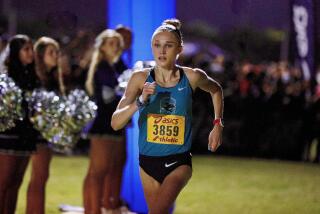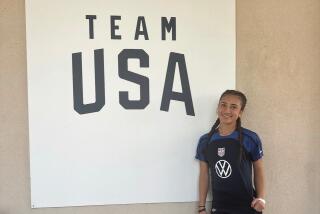Long-Distance Relationship : Cross-Country Coaches Subscribe to Differing Approaches in Developing Runners for the Rigors of Top Competition
It might surprise followers of mainstream athletics that cross-country coaches do more than say “On your mark, get set, go,” and cross their fingers while their charges disappear on 3-mile jaunts through the countryside.
Some coaches, in fact, don’t say much to shatter the stereotype. Jack Farrell, whose boys’ teams at Thousand Oaks High have won three Southern Section 4-A Division titles in the 1980s, insists there are no secrets or magic workouts for success. “If you train hard,” he said, “you’ll race fast.”
He makes coaching cross-country sound easy. It isn’t.
Among the questions a coach must address in developing a regimen are: How many miles should athletes run? Should they run twice a day? What type of intervals--shorter distances frequently run at race pace--should they run? What type of hill training? Should they lift weights? How often should they race? What’s the best way to attain a peak performance at the end of the season?
Weekly mileage is one of the most important factors in a successful cross-country program because it establishes a team’s endurance and strength. But because physical and mental factors must be considered when plotting training mileage, approaches vary.
Too many miles can lead to injuries and mental burnout, but too few miles won’t develop the endurance and strength essential to successful cross-country racing.
Arroyo, winner of the inaugural state Division I championship last year, is a high-mileage program, averaging 70 to 80 miles a week during the summer and 60 to 65 miles a week once the season starts, including 2 runs a day, 3 days a week.
Thousand Oaks runners log 50 miles a week during the season. Camarillo and Agoura, the Valley-area’s top programs last season, run 40 to 45 weekly miles.
“Running 70 to 80 miles a week during the summer lays the groundwork for a successful season,” said Tim O’Rourke, whose teams at Arroyo have won 4 Southern Section titles since 1982. “It helps build the stamina to run all-out for a three-mile race and it builds the strength to run up and down hills as quickly as possible.”
Gene Blankenship, whose Hart team has placed in the top 4 in the 3-A Division since 1984, shares O’Rourke’s philosophy but fears that increased mileage leads to injuries.
“There’s no doubt that a high school kid is going to be stronger when he’s running 70 miles a week than 50,” Blankenship said. “But what good does that do if he’s injured all the time?”
Camarillo Coach Mike Smith concurred: “I’d rather have a kid undertrained and healthy than overtrained and hurt.”
Many coaches fear that an athlete may burn out if he runs too frequently during the high school years.
“As a coach, I think it’s my responsibility to think of their future,” Agoura’s Bill Duley said. “I’d like to see them run in college. That’s where they can experiment with two-a-days and the heavier mileage.”
Canyon Coach Ed Chaidez, the 1975 NCAA Division II 6-mile champion at Cal State Northridge, said: “I’d rather see them run well in high school and get into a successful college program than have them run great and be burned out by the time they graduate.”
Bryan Dameworth of Agoura, the defending state Division I cross-country champion, said that mileage affects runners differently.
“It just depends on the individual,” he said. “Some guys thrive on the higher mileage. I, myself, feel very comfortable running 40-50 miles a week. . . . But I’m sure my mileage will increase once I get to college.”
Many coaches supplement their training regimen with weightlifting to improve endurance--not muscle bulk--because a strong, efficient upper body is essential to running hills well. A runner’s arms act like pistons powering a car engine. The faster the arms go, the faster the legs go. If the arms slow down, so will the legs.
Runners at Arroyo, Agoura and Hart lift weights 2 or 3 times a week.
“It definitely helps the kids,” Blankenship said. “Not only physically but psychologically as well. They feel stronger and that gives them more confidence.”
Dameworth began lifting weights with his arms as a freshman and added leg weights to his training regimen this season.
“I feel stronger now when I’m running,” he said. “And I’m also more confident because I know I’ve put in the extra work.”
O’Rourke is unconvinced about the physical benefits of weight training, but he agrees with Blankenship about the mental advantages.
“I’ve read articles which said weight training might be detrimental to the aerobic capacity of your body,” O’Rourke said. “But I think it’s good for the kids’ mental outlook. It gives them an improved self-image.”
Runners at Hart and Agoura also lift weights with their legs--to prevent injuries to the knees and ankles--while runners at Arroyo and Thousand Oaks incorporate bounding and lunging drills into workouts for the same purpose.
“Your knees and ankles really take a pounding in cross-country,” Duley said. “If they’re not strong, injuries will occur sooner or later.”
In addition to weekly mileage and weight training, races themselves are an important part of training. How well a team races at the end of the season often relates to how many races a team runs during the season.
“The kids love to race,” Duley explained. “That’s why they’re running cross-country. I figure the races keep their interest up.”
Thousand Oaks runs 16 or 17 races a season, but O’Rourke said that’s too many and limits Arroyo’s schedule to 12 or 13 races.
Eight to 10 races a season would be ideal, according to Blankenship, but that’s difficult if a team has 5 league dual meets as does Hart. A team cannot afford to drop the invitationals from its schedule if it wants to run against the best competition.
Because of Arroyo’s strength in recent years, O’Rourke often had his junior varsity team run in the varsity dual meets, which allowed the Knights’ best runners to rest for the invitationals.
The success of any team is measured in how well its runners perform in championship competition. Getting a cross-country runner to peak, though, is not easy.
“It’s one of the hardest things in the world to do,” Blankenship said. “I’ve read hundreds of books and articles on the subject and everyone of them says you taper the kids’ workouts. You let them rest and they’ll run well.
“It makes sense physiologically, but it’s never worked for me. If you taper the kids too much, they come out flat and don’t run well.
“I don’t think it’s a physical problem. I think it’s mental. The minute you taper their workouts, something clicks in their minds and they say to themselves, ‘This must be a really, really important race, ‘ and they freeze up.”
Farrell said the best way to get high school runners to peak is not to rest them, but to train them as hard as usual.
“If you rest them, their bodies don’t respond well,” he said. “And neither do their minds.”
Chaidez discusses race strategy with his team several days in advance of a big meet, which gives them time to analyze it.
“That way they know exactly what they’re going to do the day of the race,” he explained. “There are no questions in their minds. They have a plan and they’re going to stick to it.”
Farrell takes a hands-off approach to the mental aspects of peaking. “Most coaches assume that kids are dim-witted,” he said, “that they don’t know when it’s an important race. But the kids know when they have to race fast.”
Not surprisingly, Farrell eschews pep talks.
“The last pep talk I gave was in 1977 before the Newbury Park dual meet,” he said. “I gave this great speech--Knute Rockne would have been proud--but the team went out and folded up its tent. Newbury Park killed us.
“A week later, I didn’t say a thing and the kids beat everybody in the Ventura County Championships.”
O’Rourke puts more pressure on his team than Farrell, but he, too, refrains from the “win-one-for-the-gipper” mentality.
“Before the Southern Section championships I only tell the kids two things,” he said. “Number one, no matter how we run, the sun is going to rise tomorrow. This race is not the end of the world.
“Secondly, if you wake up tomorrow and you can say ‘I ran as fast as I could,’ then you did your job.”
More to Read
Get our high school sports newsletter
Prep Rally is devoted to the SoCal high school sports experience, bringing you scores, stories and a behind-the-scenes look at what makes prep sports so popular.
You may occasionally receive promotional content from the Los Angeles Times.






